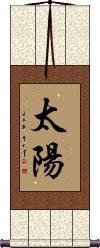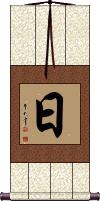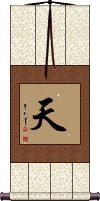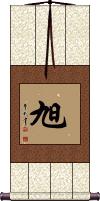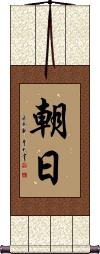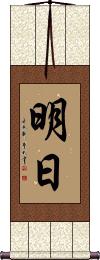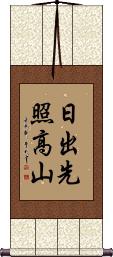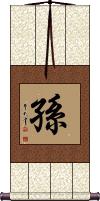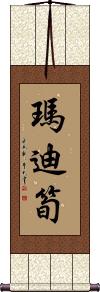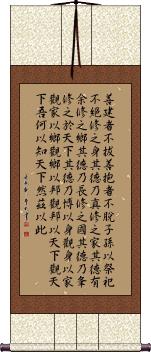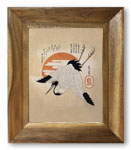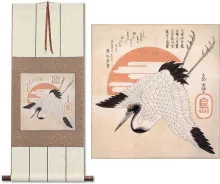Many custom options...
And formats...

Sun in Chinese / Japanese...
Buy a Sun calligraphy wall scroll here!
Personalize your custom “Sun” project by clicking the button next to your favorite “Sun” title below...
1. Sun
2. Sun / Solar
3. Heaven
4. Morning Sun
5. Sun Goddess
6. Day
11. When the sun rises it first shines on the highest mountain
12. Sune
13. Sunn
14. Sohn
15. Elson
16. Gerson
17. Madisson
18. Assuncao
太陽 is a two-character title for the Sun.
This refers specifically to Sol, the star at the center of our Solar system.
In Japanese, this is often romanized as Taiyou or Taiyo but can also be pronounced as the names Minami, Hiroaki, Hinata, Hikaru, Tsubasa, Tahi, Takayasu, Takaharu, or Soru.
Sun / Solar
Also means Day, Sunshine, Sunlight, or Japan
日 is the word for sun.
It also means day and can refer to the day of the month when expressing the date.
Example: October 1st would be “10 Moons, 1 Sun.”
日 is also the first Kanji for the title of Japan (in Chinese, Japanese Kanji, and Korean Hanja). Thus, this character is used as an adjective for things that are Japanese.
Ever heard of Japan being called, “The land of the rising sun”? Well, that's what the full title of Japan means.
Depending on the context, this character can mean Sunshine or Sunlight.
Note: In Japanese, this Kanji has a variety of possible pronunciations. The pronunciation changed depending on context and how this Kanji is combined with other Kanji. When used alone, this is usually "hi" (pronounced like "hee") but sometimes it’s "nichi." When combined, it can be "tsu," "ni," "ka," and a few others.
Heaven
天 means “heaven” or “sky” in Chinese, Japanese Kanji, and old Korean Hanja.
The context determines if you are talking about heaven or the sky above (often they are the same concept).
When combined with other characters, words like “today” and “tomorrow” are created. While sometimes the character for “sun” is used to mean “day,” often “sky” represents “day” in Asian languages.
Example: 今天 (this sky) = “today,” 明天 (next sky) = “tomorrow” in modern Chinese and Japanese.
In Chinese culture, regardless of which religion, it's almost always assumed that God (and any other deities) live up above the sky. The concept of God living in the sky is likely the reason heaven is associated with this character.
The equation goes something like this: God's domain is the sky, thus, the sky is heaven.
Note: As a single character, this is a little ambiguous, so you might want to choose our Kingdom of Heaven selection instead.
Morning Sun
This Chinese, Japanese, and old Korean character means morning sun, dawn, or rising sun.
It can also be the Japanese surname Kyoku or Asahi.
Sun Goddess
天照皇大神 is the title for Sun Goddess or Amaterasu Oomikami in Japanese.
Rare Chinese Buddhists/Shitoists may be familiar with this (so I have included the Chinese pronunciation above) however, this should generally be considered a specifically-Japanese title.
Besides Amaterasuoomikami, this can also be pronounced/romanized as Tenshoukoudaijin. There are several similar ways to write Sun Goddess in Japanese, so don't be surprised if you see different forms on the web, etc.
This is how to write “day” in Chinese, Japanese, and Korean Hanja.
This can also mean “Sun,” the star in the middle of the Solar system in which we live. In Japanese, it can also mean “sunshine” or even “Sunday.”
When writing the date in modern Chinese and Japanese, putting a number in front of this character indicates the day of the month. Of course, you need to indicate the month too... The month is expressed with a number followed by the character for the moon. So “three moons ten suns” would be “March 10th” or “3/10.”
Note: This is also the first character for the proper name of Japan. Remember that Japan is “The land of the rising sun”? Well, the first character for Japan means “sun” and the second means “origin” so you get the real meaning now. Sometimes, in China, this sun character can be a short name for Japan or a suffix for something of or from Japan.
Asahi / Morning Sun
朝日 is a version of the Japanese name Asahi.
This can also be Ahisa, Asuka, Ashita, or Asaka. This means morning sun and is the name of the famous beer company in Japan.
This would be read as “Zhao Ri” in Mandarin where it means morning sun but is also known to be the Asahi company (maker of beer and other beverages).
Sun Moon Stars
The Sun, Moon, and Stars
日月星辰 is a title that encompasses all of the heavenly bodies or celestial bodies.
Namely, this includes the Sun, Moon, and Stars of our universe.
Tomorrow / The Next Sun
When the sun rises it first shines on the highest mountain
This old Buddhist phrase means, “When the sun rises it always shines first on the highest mountain,” or “When the sun appears, it first casts its light upon the highest mountain.”
This comes from the Avatamsaka Sutra and has been used as the name or portion of the name for temples in Japan and sites in China.
The Buddha's first round of teaching (Avatamsaka period) is likened to the time when the sun rises from the east horizon. When the sun first rises it illuminates the high mountains. In this analogy, the high mountains represent the great Bodhisattvas and/or those most ready to receive enlightenment and liberation.
This can be romanized from Japanese as “Nichi shutsu sen shō kō san,” “Nisshutsu saki teru takayama,” or “Hide temazu kōzan wo terasu yama.” The last one is probably the most common. Ask three Japanese people what they think the pronunciation is, and you will get three different opinions.
Sune
Sunn
Sohn
Elson
Gerson
Madisson
Assuncao
Daodejing / Tao Te Ching - Chapter 54
This is the Mawangdui version of Daodejing chapter 54.
By its virtue alone can one generation after another carry on the ancestral sacrifice.
Apply it to yourself, and by its power, you will be freed from dross.
Apply it to your household, and your household shall thereby have abundance.
Apply it to the village, and the village will be made secure.
Apply it to the kingdom, and the kingdom shall thereby be made to flourish.
Apply it to an empire, and the empire shall thereby be extended.
Therefore just as through oneself, one may contemplate Oneself;
So through the household one may contemplate the Household;
And through the village, one may contemplate the Village;
And through the kingdom, one may contemplate the Kingdom;
And through the empire, one may contemplate the Empire.
How do I know that the empire is so? By this.
What is firmly rooted cannot be pulled out;
What is tightly held in the arms will not slip loose;
Through this, the offering of sacrifice by descendants will never come to an end.
Cultivate it in your person, and its virtue will be genuine;
Cultivate it in the family, and its virtue will be more than sufficient;
Cultivate it in the hamlet, and its virtue will endure;
Cultivate it in the state, and its virtue will abound;
Cultivate it in the empire, and its virtue will be pervasive.
Hence look at the person through the person;
Look at the family through the family;
Look at the hamlet through the hamlet;
Look at the state through the state;
Look at the empire through the empire.
How do I know that the empire is like that?
By means of this.
This in-stock artwork might be what you are looking for, and ships right away...
Gallery Price: $61.00
Your Price: $33.88
Gallery Price: $61.00
Your Price: $33.88
Gallery Price: $61.00
Your Price: $33.88
Gallery Price: $61.00
Your Price: $33.88
Gallery Price: $96.00
Your Price: $52.88
Gallery Price: $96.00
Your Price: $52.88
Gallery Price: $72.00
Your Price: $39.88
Not the results for sun that you were looking for?
Below are some entries from our dictionary that may match your sun search...
| Characters If shown, 2nd row is Simp. Chinese |
Pronunciation Romanization |
Simple Dictionary Definition |
孫 孙 see styles |
sūn sun1 sun yuzuru ゆずる |
More info & calligraphy: Sunngrandchild; (given name) Yuzuru Grandchild; grandson; translit. sun. |
孫悟空 孙悟空 see styles |
sūn wù kōng sun1 wu4 kong1 sun wu k`ung sun wu kung songokuu / songoku そんごくう |
More info & calligraphy: Sun Wukong / Son Goku(1) (char) Sun Wukong (character in the classic Chinese novel Journey to the West); Monkey King; (2) (char) Son Goku (Dragon Ball); (ch) Sun Wukong (character in the classic Chinese novel Journey to the West); Monkey King; (ch) Son Goku (Dragon Ball) |
孫燕姿 孙燕姿 see styles |
sūn yàn zī sun1 yan4 zi1 sun yen tzu |
More info & calligraphy: Stefanie |
損 损 see styles |
sǔn sun3 sun takuji たくじ |
to decrease; to lose; to damage; to harm; (coll.) to ridicule; to deride; (coll.) caustic; sarcastic; nasty; mean; one of the 64 hexagrams of the Book of Changes: ䷨ (n,adj-na,vs,vi) (1) loss; damage; harm; unprofitable; (noun or adjectival noun) (2) disadvantage; handicap; drawback; unfavorable; (personal name) Takuji To spoil, hurt, damage. |
搎 see styles |
sūn sun1 sun |
to rub with the hand; to stroke |
榫 see styles |
sǔn sun3 sun |
(cabinetmaking) tenon |
猻 狲 see styles |
sūn sun1 sun |
used in 猢猻|猢狲[hu2 sun1]; used in 兔猻|兔狲[tu4 sun1] |
笋 see styles |
sǔn sun3 sun takanna たかんな |
variant of 筍|笋[sun3] (1) (kana only) bamboo shoot; (2) (abbreviation) (kana only) inexperienced doctor; quack; (out-dated or obsolete kana usage) (kana only) bamboo shoot; (place-name) Takanna |
筍 笋 see styles |
sǔn sun3 sun takouna / takona たこうな takenoko たけのこ takanna たかんな takamuna たかむな |
bamboo shoot (1) (kana only) bamboo shoot; (2) (abbreviation) (kana only) inexperienced doctor; quack; (out-dated or obsolete kana usage) (kana only) bamboo shoot |
簨 see styles |
sǔn sun3 sun |
cross-beam for hanging bells |
蓀 荪 see styles |
sūn sun1 sun |
fragrant grass |
隼 see styles |
sǔn sun3 sun hayabusa はやぶさ |
falcon; Taiwan pr. [zhun3] (kana only) falcon (esp. the peregrine falcon, Falco peregrinus); (surname) Hayabusa |
飧 see styles |
sūn sun1 sun |
(literary) supper |
飱 飧 see styles |
sūn sun1 sun san |
variant of 飧[sun1] to dine |
不損 不损 see styles |
bù sǔn bu4 sun3 pu sun fuson |
not harming |
兒孫 儿孙 see styles |
ér sūn er2 sun1 erh sun jison |
descendant descendants |
兔猻 兔狲 see styles |
tù sūn tu4 sun1 t`u sun tu sun |
Pallas's cat (Otocolobus manul) |
全損 全损 see styles |
quán sǔn quan2 sun3 ch`üan sun chüan sun zenson ぜんそん |
(insurance) total loss total loss |
公孫 公孙 see styles |
gōng sūn gong1 sun1 kung sun kouson / koson こうそん |
two-character surname Gongsun (surname, given name) Kōson |
冬筍 冬笋 see styles |
dōng sǔn dong1 sun3 tung sun |
winter bamboo shoots (smaller and tenderer as a result of being dug out before they come out of the soil) |
割損 割损 see styles |
gē sǔn ge1 sun3 ko sun |
circumcision (Bible term) |
勞損 劳损 see styles |
láo sǔn lao2 sun3 lao sun rōson |
strain (medicine) fatigue |
卡榫 see styles |
kǎ sǔn ka3 sun3 k`a sun ka sun |
clip; latch (on a clip-into-place component) |
卯榫 see styles |
mǎo sǔn mao3 sun3 mao sun |
mortise and tenon (slot and tab forming a carpenter's joint) |
參孫 参孙 see styles |
cān sūn can1 sun1 ts`an sun tsan sun |
Samson, biblical figure in the Book of Judges known for his strength and feats against the Philistines |
又損 又损 see styles |
yòu sǔn you4 sun3 yu sun mata son su |
further lessens |
受損 受损 see styles |
shòu sǔn shou4 sun3 shou sun |
to suffer damage |
嘴損 嘴损 see styles |
zuǐ sǔn zui3 sun3 tsui sun |
(dialect) sharp-tongued; harsh |
外孫 外孙 see styles |
wài sūn wai4 sun1 wai sun gaison; sotomago がいそん; そとまご |
daughter's son; grandson; descendant via the female line grandchild from a daughter married into another family |
姪孫 侄孙 see styles |
zhí sūn zhi2 sun1 chih sun tesson てっそん |
grandnephew grandniece; grandnephew |
Click here for more sun results from our dictionary
The following table may be helpful for those studying Chinese or Japanese...
| Title | Characters | Romaji (Romanized Japanese) | Various forms of Romanized Chinese | |
| Sun | 太陽 太阳 | tai you / taiyou / tai yo | tài yang / tai4 yang5 / tai yang / taiyang | t`ai yang / taiyang / tai yang |
| Sun Solar | 日 | hi / nichi | rì / ri4 / ri | jih |
| Heaven | 天 | ten | tiān / tian1 / tian | t`ien / tien |
| Morning Sun | 旭 | asahi | xù / xu4 / xu | hsü |
| Sun Goddess | 天照皇大神 | amaterasuoomikami amaterasuomikami | tiān zhào huáng dà shén tian1 zhao4 huang2 da4 shen2 tian zhao huang da shen tianzhaohuangdashen | t`ien chao huang ta shen tienchaohuangtashen tien chao huang ta shen |
| Day | 日 | hi / nichi | rì / ri4 / ri | jih |
| Asahi Morning Sun | 朝日 | asahi | zhāo rì zhao1 ri4 zhao ri zhaori | chao |
| Sun Moon Stars | 日月星 | nichigetsusei | rì yuè xīng ri4 yue4 xing1 ri yue xing riyuexing | jih yüeh hsing jihyüehhsing |
| The Sun, Moon, and Stars | 日月星辰 | nichigetsuseishin | rì yuè xīng chén ri4 yue4 xing1 chen2 ri yue xing chen riyuexingchen | jih yüeh hsing ch`en jihyüehhsingchen jih yüeh hsing chen |
| Tomorrow The Next Sun | 明日 | ashita / meibi | míng rì / ming2 ri4 / ming ri / mingri | ming jih / mingjih |
| When the sun rises it first shines on the highest mountain | 日出先照高山 | hiide temazu kousan wo terasu yama hide temazu kosan wo terasu yama | rì chū xiān zhào gāo shān ri4 chu1 xian1 zhao4 gao1 shan1 ri chu xian zhao gao shan richuxianzhaogaoshan | jih ch`u hsien chao kao shan jihchuhsienchaokaoshan jih chu hsien chao kao shan |
| Sune | 孫 孙 | sūn / sun1 / sun | ||
| Sunn | 孫 孙 | sūn / sun1 / sun | ||
| Sohn | 孫 孙 | sūn / sun1 / sun | ||
| Elson | 埃爾孫 埃尔孙 | āi ěr sūn ai1 er3 sun1 ai er sun aiersun | ai erh sun aierhsun |
|
| Gerson | 蓋爾孫 盖尔孙 | gài ěr sūn gai4 er3 sun1 gai er sun gaiersun | kai erh sun kaierhsun |
|
| Madisson | 瑪迪筍 玛迪笋 | mǎ dí sǔn ma3 di2 sun3 ma di sun madisun | ma ti sun matisun |
|
| Assuncao | 阿筍薩奧 阿笋萨奥 | ā sǔn sà ào a1 sun3 sa4 ao4 a sun sa ao asunsaao | ||
| Daodejing Tao Te Ching - Chapter 54 | 善建者不拔善抱者不脫子孫以祭祀不絕修之身其德乃真修之家其德有余修之鄉其德乃長修之國其德乃夆修之於天下其德乃博以身觀身以家觀家以鄉觀鄉以邦觀邦以天下觀天下吾何以知天下然茲以此 善建者不拔善抱者不脱子孙以祭祀不绝修之身其德乃真修之家其德有余修之乡其德乃长修之国其德乃夆修之于天下其德乃博以身观身以家观家以乡观乡以邦观邦以天下观天下吾何以知天下然兹以此 | shàn jiàn zhě bù bá shàn bào zhě bù tuō zǐ sūn yǐ jì sì bù jué xiū zhī shēn qí dé nǎi zhēn xiū zhī jiā qí dé yǒu yú xiū zhī xiāng qí dé nǎi zhǎng xiū zhī guó qí dé nǎi féng xiū zhī yú tiān xià qí dé nǎi bó yǐ shēn guān shēn yǐ jiā guān jiā yǐ xiāng guān xiāng yǐ bāng guān bāng yǐ tiān xià guān tiān xià wú hé yǐ zhī tiān xià rán zī yǐ cǐ shan4 jian4 zhe3 bu4 ba2 shan4 bao4 zhe3 bu4 tuo1 zi3 sun1 yi3 ji4 si4 bu4 jue2 xiu1 zhi1 shen1 qi2 de2 nai3 zhen1 xiu1 zhi1 jia1 qi2 de2 you3 yu2 xiu1 zhi1 xiang1 qi2 de2 nai3 zhang3 xiu1 zhi1 guo2 qi2 de2 nai3 feng2 xiu1 zhi1 yu2 tian1 xia4 qi2 de2 nai3 bo2 yi3 shen1 guan1 shen1 yi3 jia1 guan1 jia1 yi3 xiang1 guan1 xiang1 yi3 bang1 guan1 bang1 yi3 tian1 xia4 guan1 tian1 xia4 wu2 he2 yi3 zhi1 tian1 xia4 ran2 zi1 yi3 ci3 shan jian zhe bu ba shan bao zhe bu tuo zi sun yi ji si bu jue xiu zhi shen qi de nai zhen xiu zhi jia qi de you yu xiu zhi xiang qi de nai zhang xiu zhi guo qi de nai feng xiu zhi yu tian xia qi de nai bo yi shen guan shen yi jia guan jia yi xiang guan xiang yi bang guan bang yi tian xia guan tian xia wu he yi zhi tian xia ran zi yi ci | shan chien che pu pa shan pao che pu t`o tzu sun i chi ssu pu chüeh hsiu chih shen ch`i te nai chen hsiu chih chia ch`i te yu yü hsiu chih hsiang ch`i te nai chang hsiu chih kuo ch`i te nai feng hsiu chih yü t`ien hsia ch`i te nai po i shen kuan shen i chia kuan chia i hsiang kuan hsiang i pang kuan pang i t`ien hsia kuan t`ien hsia wu ho i chih t`ien hsia jan tzu i tz`u shan chien che pu pa shan pao che pu to tzu sun i chi ssu pu chüeh hsiu chih shen chi te nai chen hsiu chih chia chi te yu yü hsiu chih hsiang chi te nai chang hsiu chih kuo chi te nai feng hsiu chih yü tien hsia chi te nai po i shen kuan shen i chia kuan chia i hsiang kuan hsiang i pang kuan pang i tien hsia kuan tien hsia wu ho i chih tien hsia jan tzu i tzu |
|
| In some entries above you will see that characters have different versions above and below a line. In these cases, the characters above the line are Traditional Chinese, while the ones below are Simplified Chinese. | ||||
Successful Chinese Character and Japanese Kanji calligraphy searches within the last few hours...
